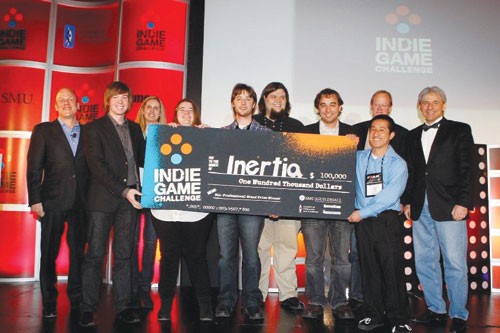
SMU Guildhall graduate students, Evan Skarin (from left) Michelle Hayden, John Bevis, Brandon Stephens, William Swannack, and Wayland Fong receive the Indie Game Challenge award for their video game, “Inertia,” on Jan. 20. (Photo Courtesy of Ron Jenkins)
Most students think of XBOX games only as entertainment. At SMU’s Guildhall, video games are both a fun activity and a serious academic subject.
For the eight SMU graduate students of Team Hermes, video games are their claim to fame.
Team Hermes recently won the Indie Games Challenge, earning $130,000 in cash and prizes. This is the first international win for Guildhall. Their video game, Inertia, is a 2D arcade game in which the player navigates out of a decaying spaceship by manipulating gravity. Inertia is now available for purchase on XBOX Live Indie for $1 or 80 Microsoft Points.
No one involved in Team Hermes predicted the outcome.
Ron Jenkins, the deputy director of development and external affairs at Guildhall, explains that Team Hermes could only work on Inertia for “12 weeks, while at other schools, graduate students would work on their projects for about two years.”
Erasmo Simo described the development process as “rushed.”
“We decided to enter like a week before the deadline . . . and submit[ted] the game right at last minute,” Simo said.
According to Stephens, Team Hermes had to develop Inertia along “with a full work load from other classes.”
“We expected to get to semi-finals, even the finals, and use that as a good point on our resumes. I don’t think any of us was shooting for the grand prize,” Simo said.
Inertia won the Non-Professional Grand Prize of $100,000, Gamers’ Choice Award (voted on by the public), Achievement in Gameplay and in Technical Achievement.
C. Brandon Stephens explained the structure of the Team Hermes as “a conjunction of two teams.”
Evan Skarin was team leader and was also a part of art. Wayland Fong and William Swannick were responsible for programming, John Bevis was the sound engineer and Michelle Hayden was leader of art design. Skarin, Fong, and Bevis all also worked on level design.
Team productions was responsible for creating six news levels and two new game modes for the XBOX Live Indie version of Inertia. Stephens was executive producer, McCrimmons was producer and Simo was programmer.
The Guildhall is ranked as the premier video game design school in the nation. Team Hermes’ victory only furthers its stellar reputation.
“We want to be the Harvard Medical School of video games,” Jenkins said.
The Guildhall at SMU is located on the SMU-in-Plano campus.










